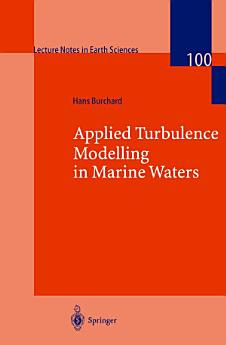Applied Turbulence Modelling in Marine Waters
Hans Burchard
আগ ২০০৭ · Lecture Notes in Earth Sciences বই 100 · Springer
ই-বুক
218
পৃষ্ঠা
reportরেটিং ও রিভিউ যাচাই করা হয়নি আরও জানুন
এই ই-বুকের বিষয়ে
The simulation of turbulent mixing processes in marine waters is one of the most pressing tasks in oceanography. It is rendered difficult by the various complex phenomena occurring in these waters like strong stratification, ex ternal and internal waves, wind generated turbulence, Langmuir circulation etc. The need for simulation methods is especially great in this area because the physical processes cannot be investigated in the laboratory. Tradition ally, empirical bulk type models were used in oceanography, which, however, cannot account for many of the complex physical phenomena occurring. In engineering, statistical turbulence models describing locally the turbulence mixing processes were introduced in the early seventies, such as the k E model which is still one of the most widely used models in Computational Fluid Dy namics. Soon after, turbulence models were applied more and more also in the atmospheric sciences, and here the k kL model of Mellor and Yamada became particularly popular. In oceanography, statistical turbulence mod els were introduced rather late, i. e. in the eighties, and mainly models were taken over from the fields mentioned above, with some adjustments to the problems occurring in marine waters. In the literature on turbulence model applications to oceanography problems controversial findings and claims are reported about the various models, creating also an uncertainty on how well the models work in marine water problems.
ই-বুকে রেটিং দিন
আপনার মতামত জানান।
পঠন তথ্য
স্মার্টফোন এবং ট্যাবলেট
Android এবং iPad/iPhone এর জন্য Google Play বই অ্যাপ ইনস্টল করুন। এটি আপনার অ্যাকাউন্টের সাথে অটোমেটিক সিঙ্ক হয় ও আপনি অনলাইন বা অফলাইন যাই থাকুন না কেন আপনাকে পড়তে দেয়।
ল্যাপটপ ও কম্পিউটার
Google Play থেকে কেনা অডিওবুক আপনি কম্পিউটারের ওয়েব ব্রাউজারে শুনতে পারেন।
eReader এবং অন্যান্য ডিভাইস
Kobo eReaders-এর মতো e-ink ডিভাইসে পড়তে, আপনাকে একটি ফাইল ডাউনলোড ও আপনার ডিভাইসে ট্রান্সফার করতে হবে। ব্যবহারকারীর উদ্দেশ্যে তৈরি সহায়তা কেন্দ্রতে দেওয়া নির্দেশাবলী অনুসরণ করে যেসব eReader-এ ফাইল পড়া যাবে সেখানে ট্রান্সফার করুন।







